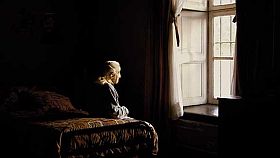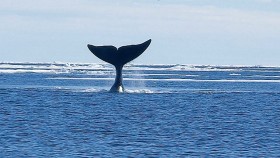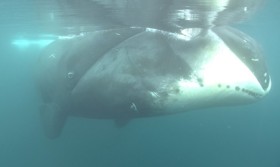


Adam Schmedes: Kampen for naturen er forudsætning
Adam Schmedes har efter anmeldelsen af “Ishavets kæmpe” sendt Filmkommentaren dette brev: “Kære Allan Berg. Efter i 6 år at have kæmpet med en meget vanskelig filmopgave, Danmarks hidtil største satsning på naturfilmområdet. En pioneropgave, idet Grønlandshvalen var nærmest umulig at filme (BBC opgav) og samtidig et koncept med historiske rekonstruktioner til søs i det arktiske.
Efter den præstation, som fik rekordstor seermodtagelse på omkring 900.000 på DR1, en god lancering og nogen presseomtale forblev filmintelligentsiaen tavs. Ingen omtale i EKKO eller andetsteds og ingen finaleplads i Robert sammenhæng for nylig.
Genren naturfilm, og det skønt jeg har skubbet kraftigt til genreopfattelsen, er åbenbart ikke noget den intellektuelle del af filmkritikken, eller filmkritikken i det hele taget, vil beskæftige sig med.
I mine fordomsfulde øjeblikke havde jeg lyst til at karakterisere disse filmkritikere enten som begrænsede af faglige vanemæssige barrierer og interesser; det er ikke film, det er fakta og vi kender intet til natur, altså en manifesteret dovenskab overfor at beskæftige sig med det universelt naturvidenskabelige indhold og dertil knyttede filmiske debat.
Men det kunne også skyldes en manglende evne, eller lyst til at skulle spejle sig i problemstillinger som ikke handlede direkte om dem selv. Det at kunne genfinde sin egen navlebeskuende opmærksomhed i andres gengivelser, med nye fascinerende detaljer.
Altså en almen humanitær følsomhed over og omkring menneskets kår og emotionelle tilstande, som karakteriserer hovedparten af både kort og langfilm, vægtet som højeste værdi.
Standpunktet bag Ishavets Kæmpe er kun humanitært i anden potens, fordi idégrundlaget bag filmen placerer kampen for naturen, som forudsætning for og dermed højere prioriteret end humanismen. Vi ser nødvendigheden af en mere arts-altruistisk universel holdning, og dermed peger vi på nødvendigheden af at ændre vores kultur, vores civilisationsmodel, så den fokuserer på helheden, snarere end navlen og inddrager en længere tidshorisont i sin perspektivering (et centralt tema i hvalfortællingen)
Efter den kraftanstrengelse og de nationale rekorder vi har opnået, stod vi, på Loke Film, midt i et tomrum, medens et hav af lette navlefilm (en betegnelse vi bruger internt og bredt om film, der psykologisk, ofte med metafysiske eller filosofiske udflugter kredser om individets eksistentielle selviscenesættelse), der kan laves inden for 1 år eller få måneder, fik al den faglige opmærksomhed, netop fra dem, vi trods alt føler os som del af, i det danske filmlandskab, hvor vi bærer vores del af ansvaret for fornyelsen af dansk film.
Jeg vil derfor takke dig fordi du har ført debatten videre og endda med stor grundighed har undersøgt vore dogme regler (Eddys dogmer) som du dermed er den første til at kaste lys over, skønt vi har arbejdet med dem i flere film, som i ”Kongen af Provence” eller ”Kamæleonernes Strand”, du tidligere har anmeldt.
Du har helt ret (afsnit 7) i at vi kunne have gjort mere ud af at stilisere rekonstruktionerne, selvom, som du påpeger, de kun har demonstrativ karikaturfunktion i dokumentartilgangen. Da vi skulle til at lave dem sidst i forløbet, havde hvaloptagelserne, samt bankerne og den finansielle krise bragt os nær bankerot, så al min personlige ejendom var sat på højkant, medens afleveringsfristen nærmede sig. Du ved hvad historiske rekonstruktioner med mand, sejlskibe, joller, kostumer, rekvisitter, dykkere etc. koster. Her havde vi ikke midler til fuldt at gribe om det du kalder spillefilmgrebet. Det beklager jeg. En stor tak fra holdet bag ”Ishavets Kæmpe”, Adam.”



